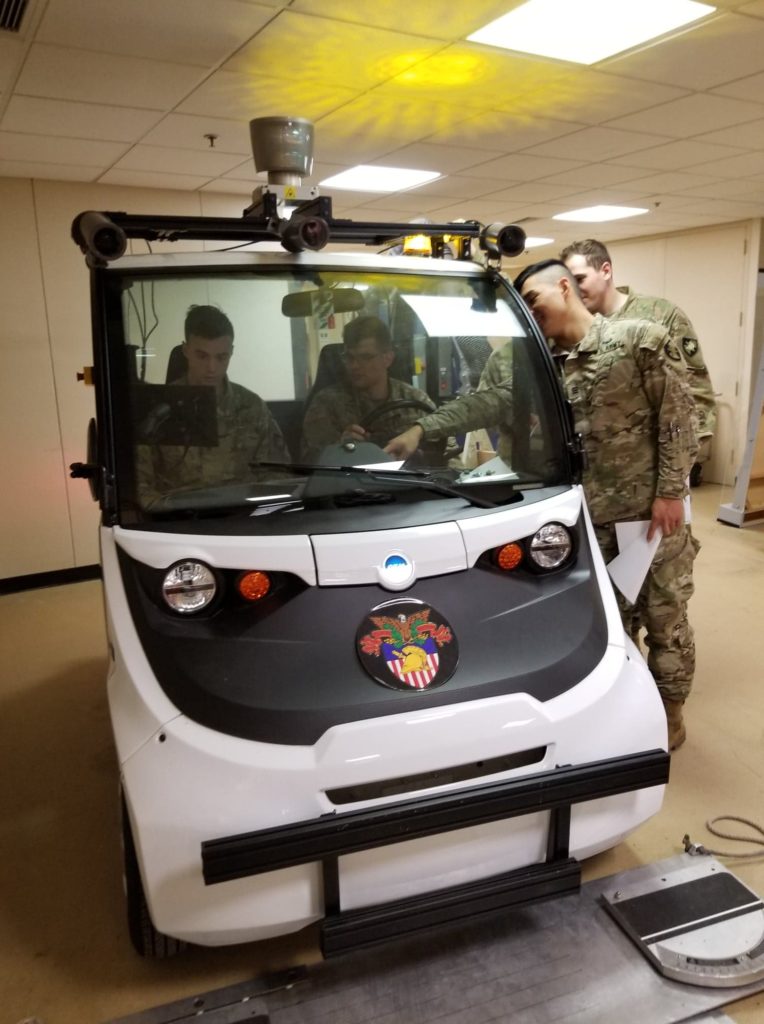West Point XE401/2: Integrated System Design Capstone
 Autonomous Urban Navigation – Fall 2019 and Spring 2020:
Autonomous Urban Navigation – Fall 2019 and Spring 2020:
Winner, EECS Department Best Project Award
Winner, EECS Department Best Final Presentation Award
I served as the lead technical instructor for the Self-Drive section of the Integrated System Design Capstone. The students were tasked with integrating on-road driving functionality to the Robotic Technology Kernel (RTK), a set of vehicle autonomy tools for U.S. Army ground vehicles. RTK was originally designed for navigating through unstructured open land, but the ability to follow traffic laws in an urban setting can allow autonomous Army vehicles to make deliveries or move personnel around in cities or on bases. Students learned the fundamentals of design and software project management while leveraging open-source solutions to develop and test independent software modules for Lane Detection, Lane Following Control, Lane Changing, Sign Detection, Obstacle Detection, Stopping, and executing Left and Right Turns at Intersections. They then integrated these modules along with a Safety System into a custom architecture using ROS. These modules can then be integrated into the Army’s overall Robotic Technology Kernel.
MIT 2.12/2.120: Introduction to Robotics
Students in 2.12 learn both a breadth of general robotics knowledge and a depth of fundamental kinematics, dynamics, force interaction, design, and feedback control for mobile and manipulator robots. In addition to lectures, problem sets, and exams, the class has a significant laboratory component involving a set of exercises designed to reinforces the lecture material through practical application and a final project for which the students must work in teams over several weeks to design and implement a robotic system that competes in a final competition. The theme of the competition varies from year to year.
Pizza Making and Delivering Robots – Spring 2019: I was a Lab Instructor for the class 2.12: Introduction to Robotics taught by Professors Harry Asada. I led some lab sections office hours, and exam review sessions. I also consulted student teams on design and implementation of Series Elastic Actuator-based collaborative robots for their final project involving assembling and delivering pizzas with various toppings to patrons at a restaurant.
 Series Elastic Actuators and Collaborative Robots – Fall 2017: I was the Classroom Teaching Assistant for the class 2.12: Introduction to Robotics taught by Professors Harry Asada and Kamal Youcef-Toumi. I provided additional coursework instruction to students via recitations, office hours, and exam review sessions. I also consulted student teams on design and implementation of Series Elastic Actuator-based collaborative robots for their final project involving robots performing tasks on behalf of users with physical disabilities.
Series Elastic Actuators and Collaborative Robots – Fall 2017: I was the Classroom Teaching Assistant for the class 2.12: Introduction to Robotics taught by Professors Harry Asada and Kamal Youcef-Toumi. I provided additional coursework instruction to students via recitations, office hours, and exam review sessions. I also consulted student teams on design and implementation of Series Elastic Actuator-based collaborative robots for their final project involving robots performing tasks on behalf of users with physical disabilities.

Laboratory Mobile Robot Redesign – Summer 2015: I redesigned all of the hardware and software for the lab component to reflect modern controls implementation techniques, and have been supporting the maintenance These components have been used successfully in every offering of the course since. Here the robots are shown following human voice commands and using machine vision to acquire medicine bottles for user with a physical disability.
Soccer Kicker and Goalie Robots – Fall 2014: I was the head Teaching Assistant for the class 2.12: Introduction to Robotics taught by Professors Harry Asada and Kamal Youcef-Toumi. I designed and implemented a high-speed computer vision and communication network to track soccer balls and relay the position to student teams in real time, Wrote base communication and actuator interface code in C++, Python, and MATLAB, and consulted student teams on design and implementation of robotic soccer kicking and goalie robot systems (2014).
Resources: